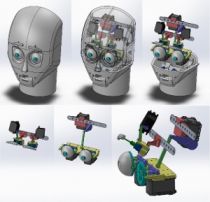Hail CAESAR!
Celebrating National Robotics Week with the humanoid robot

In celebration of National Robotics Week—which was established in 2010 to recognize robotics technology as a pillar of 21st century American innovation, highlight its growing importance in a wide variety of application areas, and emphasize its ability to inspire technology education—we revisited CAESAR (Cellularly-Accessible, Expressive, Semi-Autonomous Robot), to whom we were first introduced on Live Science in 2013.
Doctoral candidate Jared Frank and a team of his fellow students had built CAESAR using easily obtainable off-the-shelf and 3D-printed parts—including two $5 cameras embedded in the unit’s eyes--and programmed him using open-source software. CAESAR, they believed, could help people with limited mobility by moving things with his strong robotic arms, allow far-away grandparents to read to their grandchildren with a microphone and speaker set-up, and improve the communication and social skills of children on the autism spectrum by serving as a patient, interactive companion.

Since that time, Frank and his colleagues have continued to make improvements to CAESAR, who initially sported a white, mask-like face that was far from warm or emotionally appealing. Now, thanks in some part to advice from a New York City special education teacher, CAESAR boasts thicker, more humanlike lips that can curl up or down expressively and bushy, moveable eyebrows. In a scholarly paper detailing CAESAR’s development, Frank and his co-authors—Matthew Moorhead and Professor Vikram Kapila—wrote: “CAESAR’s face is made appropriately engaging and non-threatening by incorporating neonate features as general guidelines in its design. These features have been shown to be shared across a wide range of species, evoke instinctive care-taking responses from adults, and, in humans, have contributed to perceptions of child cuteness and attractive females. Specific features considered include large foreheads, large and wide set eyes, small nose, small and rounded chin, and small ears. Other features that have been shown to signal positive emotions, e.g., high eyebrows and large pupils, are also integrated into the design.”
“We are teaching CAESAR to mimic human facial expressions, much like babies learn by watching the world around them,” Frank says. “He can copy nuanced, realistic movements—lifting a brow, rolling his eyes—so that he can convey subtle emotions as well as broad displays of joy, sadness, anger, disgust, fear, and surprise.”
Frank foresees that CAESAR, who can be controlled using a smartphone app, will be of great use in various therapeutic settings. “That’s why it’s so important to everyone in the mechatronics lab that CAESAR can be easily and inexpensively replicated. We want every school, family, or agency who can use him to be able to afford to build one.”
- The PolyBOTS club at NYU Tandon is a great way for students to be introduced to the world of robotics and the necessary skills required in their development. PolyBOTS has been featured on national television and has helped the greater community by hosting workshops for secondary school students and teachers preparing for such competitions as FIRST Lego League and FIRST Robotics Competition.
- The Patent Pending club—which has as its motto “We invent stuff, and then we build it”—provides students with the opportunity to innovate with the supervision and assistance of fellow students, faculty members, and industry leaders. The club hosts monthly workshops dubbed “Arduino Playtime,” with the next event scheduled to take place on April 12. Patent Pending also holds a Women’s Coding Hour every Tuesday from 1-2 pm and a twice-weekly Creation Hour, which attracts a community of makers and hackers.




